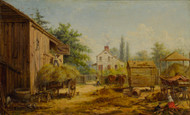Edward Lamson Henry
Published by Therese Myles on 29th Oct 2019
American artist E. L. Henry was born Edward Lamson Henry on January 12, 1841 in Charleston, South Carolina. He moved to New York after being orphaned at the age of 7 and lived there with his cousins. In Philadelphia, where Hentry attended the Pennsylvania Academy of Fine Arts, he first came to know his lifelong friend William Kulp, a professional antiquarian who helped him to develop a strong interest in collecting antiques.
In 1856 Henry continued his art education under the painter Corot and other French masters in Paris. At that time Claude Monet and Pierre-Auguste Renoir were also students at the same studio academy. After following his art training in Paris with a visit to Italy, In 1863 Henry returned permanently to the United States.
Henry spent two years sketching military scenes and portraits of Civil War soldiers. In order to gain more involvement in the war as it was happening, he took employment as a clerk working on board a transport ship. He also visited Union camps along the James River in Virginia in 1864 to sketch military life and made several drawings of African American soldiers who were camped there.
After the Civil War came to an end Henry was based in his New York studio. He was elected to the National Academy in 1869 and became known as a specialist genre painter of historic scenes, including battles, interiors and street scenes.
Henry used his growing collection of antiquities, antique ceramics, vintage costumes, exotic textiles and old carriages as authentic props for his paintings. He recreated many peaceful scenes of life in Philadelphia and New York in earlier times and some of his historical paintings were set in the Antebellum South.
Henry also had some success came from the contemporary studies he made of daily life in areas around where he lived. In addition to having a residence on Long Island, in 1884 Henry moved into a newly built home which became his main residence. This was located in the hamlet of Cragsmoor, NY on the Shawangunk Ridge in the Catskill Mountains. Henry designed his new home to incorporate some of the many architectural remains he rescued from old abandoned buildings in New York City.
Henry housed his collection of horse-drawn carriages at Cragsmore. He also filled his studio there with antiques and other pieces from his collection of architectural pieces and antiquities. Cragsmore village soon developed as a colony of artists with its own archive and library.
Henry enjoyed a long and successful career as an artist. His paintings became very popular because of the way he structured his compositions and was able to recreate events from recent American history in a way that made them easy to understand.
After the death of E. L. Henry on May 9, 1919 his popularity as an artist continued and his works had an influence on America’s view of its colonial past. His grave is marked appropriately with a tombstone in the shape of an artist’s palette.

